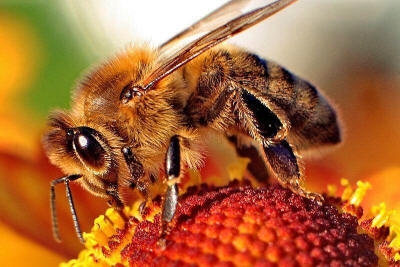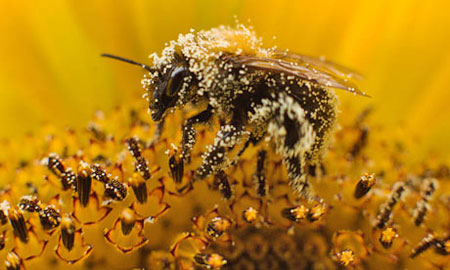|

by Lisa Archer
March 25, 2013
from
FOE Website

Spring is in the air, and as we plant
our vegetable gardens and enjoy the blossoming flowers, it’s easy to
forget the small creatures that keep many of our spring favorites
alive and are essential to our food supply: bees.
One out of every three bites of food
you and I eat is pollinated by honeybees. In fact, bees
and other pollinators are necessary for
about 75 percent of our global food crops.
From nuts and soybeans, to squash and
cucumbers, from apples, oranges, cherries and blueberries, to
avocados, peaches and melons, bees play a critical role in producing
the food we eat. Honey bees also contribute
over $15 billion to the U.S. economy.
Bees are a keystone species and with
roughly 80 percent of all flowering plants on the earth reliant on
pollinators to reproduce, if we lose bees we will likely lose a host
of other important species.
As you may have read in the news, these
critical pollinators are in trouble, victims of
Colony Collapse Disorder - or CCD, a phenomenon in which bee
colonies have been mysteriously collapsing when adult bees seemingly
abandon their hives. This last winter, beekeepers reported bee
die-offs of more than 50 percent --
the worst loss in more than 40 years.
CCD has pushed the beekeeping industry
in the U.S. to the verge of collapse, and this could spell trouble
for a variety of our favorite foods from almonds to blueberries.
For years, the cause of CCD was a
scientific mystery, but a growing body of scientific evidence is
pointing to a key factor, a class of neurotoxic pesticides called
neonicotinoids, or neonics. In fact, a January 2013
European Food Safety Authority report labeled neonicotinoids as
an 'unacceptable' danger to bees.
And a
new report from the American Bird Conservancy provides
compelling evidence that neonics are also harming birds.
Neonics are the fastest-growing class of
synthetic pesticides in history, and the neonicotinoid imidacloprid
(Bayer Crop Science's
top-selling product), is currently the most widely used
insecticide in the world.
Neonics are used as seed treatments on
more than 140 crop varieties, as well as on termites, cat and dog
flea treatments, lawns, landscapes and gardens. Neonics
are persistent and last for years in the soil. They permeate the
entire plant and are expressed in pollen, nectar and guttation
droplets (dew). And, they can’t be washed off food, meaning that we
are all eating them.
What’s worse, neonics aren’t just in use
in commercial agriculture.
Many of the plants and seeds we buy in
nurseries across the U.S. have been pre-treated with the pesticides
and at much higher doses than is used on farms - so when we plant
our gardens we may unwittingly be harming bees!
The EPA approved Bayer's products based
on the companies own studies and despite mounting evidence -
including
a memo by the EPA’s own scientists discrediting Bayer’s original
study - and 1.25 million public comments, the EPA has delayed action
on neonics until 2018. Other governments haven’t been so slow to
act.
Governments in Italy, Germany, France
and elsewhere have already taken action to limit neonics, and
beekeepers there are reporting recovery.
The 2013 EFSA study has prompted the EU
Parliament to consider a two-year ban on three popular neonics.
And, due to a successful campaign by our
sister organization Friends of the Earth England, Wales, Northern
Ireland, many of the major home and garden retailers in the UK have
pledged to stop selling neonics.
Bees really are the “canary in the coal
mine” when it comes to our food, telling us that the way we produce
our food is unhealthy and unsustainable and needs a rapid transition
to sustainable, just, ecological agriculture.
A
new USDA study shows that we could move away from chemically
intensive industrial agriculture toward a system of ecologically
friendly agriculture and continue to produce enough food for us all.
Friends of the Earth has some exciting
actions coming up to save the bees and other pollinators. You’ll
have an important role to play, so check back soon.
And in the meantime, choose to buy
organic food as much as possible, and, as you plant your spring
gardens, be sure to say no to the neonics and choose certified
organic seeds and plants to help protect bees and other pollinators!
Loss of Wild Pollinators
...Serious Threat to Crop Yields - Study Finds
by Damian Carrington
28 February 2013
from
TheGuardian Website
Wild bees and other insects
twice as effective as honeybees
in producing seeds and fruit on
crops

A bee
collects pollen from a sunflower.
Photograph:
Michael Kooren/Reuters
The decline of wild bees and other
pollinators may be an even more alarming threat to crop
yields than the loss of honeybees, a worldwide study
suggests, revealing the irreplaceable contribution of wild
insects to global food production.
Scientists studied the pollination
of more than 40 crops in 600 fields across every populated
continent and found wild pollinators were twice as effective as
honeybees in producing seeds and fruit on crops including,
-
oilseed rape
-
coffee
-
onions
-
almonds
-
tomatoes
-
strawberries
Furthermore, trucking in managed
honeybee hives did not replace wild pollination when that was
lost, but only added to the pollination that took place.
"It was astonishing; the result
was so consistent and clear," said Lucas Garibaldi, at the
National University in Río Negro, Argentina, who led the
46-strong scientific team.
"We know wild insects are
declining so we need to start focusing on them. Without such
changes, the ongoing loss is destined to compromise
agricultural yields worldwide."
Pollination is needed for about
three-quarters of global food crops.
The
decline of honeybee colonies due to disease and
pesticides has prompted serious concern.
Jason Tylianakis, at the
University of Canterbury, New Zealand, described them as,
"the species charged with
protecting global food security".
The new research shows for the first
time the huge contribution of wild insects and shows honeybees
cannot replace the wild insects lost as their habitat is
destroyed.
Lucas Garibaldi said relying
on honeybees was a "highly risky strategy" because disease can
sweep through single species, as has been seen with
the varroa
mite, and single species cannot adapt to environmental changes
nearly as well as a group of wild pollinators.
"The studies show conclusively
that biodiversity has a direct measurable value for food
production and that a few managed species cannot compensate
for the biodiversity on which we depend," said Tylianakis,
who was not part of the research team.
Garibaldi's team, whose work was
published in the journal Science (Wild
Pollinators Enhance Fruit Set of Crops Regardless of Honey Bee
Abundance) on Thursday, warn:
"Global degradation of natural
services can undermine the ability of agriculture to meet
the demands of the growing, increasingly affluent, human
population."
Garibaldi said:
"Without wild pollination, you
will not get the best yields and the best agricultural land
already farmed, so it is very important to get the maximum
yield."
He added that, across the world, the
yields of crops that needed pollination were rising
significantly more slowly (see "Global
Growth and Stability of Agricultural Yield Decrease with
Pollinator Dependence") than crops that did not.
Wild pollinators perform better than
honeybees because they deploy a wider range of pollinating
techniques, such as "buzz"
pollination. They also visit more plants, meaning
much more effective cross-pollination than honeybees, which tend
to carry pollen from one flower to another on the same plant.
A
second
new study published in Science on Thursday showed more than
half the wild bee species were lost in the 20th
century in the US.
It made use of a remarkable record made of
plants and pollinators at Carlinville, Illinois between 1888 and
1891 by entomologist Charles Robertson.
Scientists combined that with data
from 1971-72 and new data from 2009-10 to discover the changes
in pollination seen over the century as widespread forest was
reduced to the fragments that remain today.
They found that half of the 109 bee
species recorded by Robertson had been lost and there had been a
serious degradation of the pollination provided by the remaining
wild insects, with their ability to pollinate specific plants
falling by more than half.
There was an increasing mismatch
between when plants flowered and when bees were active, a
finding consistent with climate change, according to the
researchers.
Laura Burkle, at Washington
University in Montana, who led the work, said:
"There are two sides to this
coin. These pollination systems are incredibly robust to
environmental change, it is almost miraculous that they
continue to pollinate given the land use changes. But the
system is also incredibly compromised and further
degradation will have serious impacts."
|


